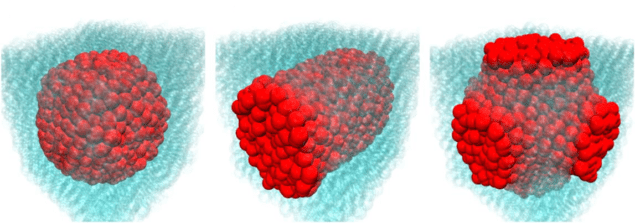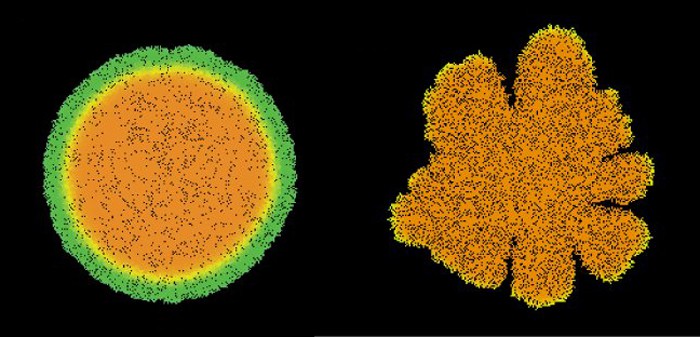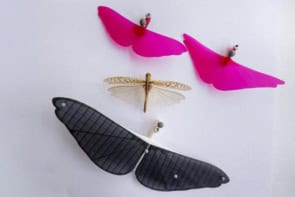
Altering the adhesion at the interface between tissues with different steady-state pressures allows the stable coexistence of the tissues – according to simulations done by physicists in Germany. Their study produced a variety of coexisting structures including spheroids akin to microscopic tumours. This has led the researchers to suggest that a reduction in adhesion could be involved in the formation of the very small, symptom-free occult tumours, which occur so abundantly in tissues.
The inherent steady-state (homeostatic) pressure of a tissue is caused by the dynamics of cell growth, division and cell death. This pressure is known to be an important factor in how different tissues compete for growth space. Cell culture and computer modelling has shown that the tissue with higher homeostatic pressure overcomes the lower-pressure tissue and eventually annihilates it. But Jens Elgeti from the Institute of Complex Systems at the Research Centre in Jülich, Germany, felt this conflicted with basic tumour biology.
“Tumours are very heterogeneous, with lots of different cells within the same tumour, so if one cell always out-competes the others, this tumour heterogeneity should not happen!” explained Elgeti. To gain a better understanding of this dilemma, Elgeti and colleagues have done a computational study of how tissue interactions affect this competition process.
How to coexist
The team took a physicist’s minimalistic approach, with the biology and biochemistry considered constant. Their model integrated mechanical factors such as the rate of cell removal by apoptosis (the normal death of cells) and external fluctuations driven by the dynamic extracellular matrix. This quantitative model has been previously shown to reasonably agree with experimental growth of cell spheroids.
The two tissues, dubbed A and B, are considered in the model and were given different homeostatic pressures. As expected, the tissue with the higher pressure annihilated the lower pressure tissue. Having established their model, Elgeti’s team started to change individual properties at the interface between the tissues. One property that they investigated is cross-adhesion, which is the sticking of cells from tissue A to tissue B, and vice versa.
Cells without cross-adhesion didn’t die, instead they developed a fascinating steady-state coexistence
Jens Elgeti
“There was a prediction in the literature, that if you have no adhesion it generates surface tension and kills any microscopic lesions, but it just didn’t work, the cells without cross-adhesion didn’t die,” explains Elgeti. “Instead they developed a fascinating steady-state coexistence,” he adds.
The simulations suggest that several stable 3D structures can coexist within a host tissue. These include spherical and cylindrical inclusions as well as layered and bi-continuous structures.
Growing together
The team then sought to understand the physical mechanism by which reduced adhesion at the tissue’s interface caused coexistence. After many attempts at cracking this question, they settled on using the slab-like coexisting geometry as the most simplistic system on which to develop an analytic model. This geometry comprises blocks of A and B tissues that abut each other at a planar interface.
They found that the reduced cross-adhesion enabled tissues to grow at the interface, and that this increased growth rate stabilized the net-apoptotic bulk. The team quantitatively described the mechanics involved, and their equations support the simulations.
Roger Bonnecaze from The University of Texas at Austin, who specializes in modelling complex materials such as tissue, commented, “The [research] provides a very provocative perspective on how two different cell types can coexist and this should encourage experimentalists to try and verify these predictions.”
Insights into tumour biology
Elgeti’s team suggest that the link between cross-adhesion and tissue coexistence could contribute to the stable coexistence of microscopic lesions, which are thought to occur in abundance in every human body. But they are also excited about the role their mechanism might play in cancer evolution – the series of steps that alters a healthy tissue into a malignant tumour. So the team have started to investigate what happens when gradual changes are made to adhesion strength.

Pushy bacteria could shed light on tumour growth
“Here we tried the extreme [no cross-adhesion], but as cross-adhesion approaches the bulk-adhesion strength, coexistence disappears and is replaced by random mixtures of both cell types. The very existence of heterogeneous states opens novel routes for understanding tumour evolution,” said Elgeti.
Bonnecaze is interested in the perspectives raised by the research but is uncertain as to whether mechanical perspectives will impact cancer treatment, which fundamentally attacks the biochemical activities that drive these processes. However, he is intrigued by how these mechanisms could aid the integration of tissues within artificially synthesized organs.
The research is described in the New Journal of Physics.



